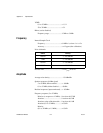Chapter 2 Hardware Overview
© National Instruments Corporation 2-3 NI 5620 User Manual
Conditioning the Signal—Impedance, Dither, Gain, and AC Coupling
To minimize distortion, signals receive a minimal amount of conditioning.
There is one set gain, and all signals are AC coupled, meaning that the
NI 5620 rejects any DCportion of asignal. The NI 5620 also hasa set input
impedance of 50 Ω and applies dither to the configurable signal.
Input Impedance
The input impedance of the NI 5620 is 50 Ω. The output impedance of the
source connected to the NI 5620 and the input impedance of the NI 5620
form an impedance divider, which attenuates the input signal according to
the following formula:
where V
m
is the measured voltage
V
s
is the unloaded source voltage
R
s
is the output impedance of the external device
R
in
is the input impedance of the NI 5620
If the source whose output you are measuring has an output impedance
other than 50 Ω, your measurements will be affected by this impedance
divider. For example, if the device has 75 Ω output impedance, your
measured signal will be 80% of the value it would have been at 50 Ω.
Dither
Dither is random noise added to the input signal between 0 and 5 MHz.
Dither lowers the amount of distortion caused by differential nonlinearity
in the ADC when asignal is digitized. Whenan FFT is appliedto thesignal,
this random noise cancels out most of the distortion created by differential
nonlinearity. Dither is not automatically applied, but you can enable it in
software.
Digitizing the Signal—The ADC
Regardless of your requested sample rate, the NI 5620 ADC is always
running at 64 MS/s. If you request a rate less than 64 MS/s, the timing
engine of the NI 5620 stores only 1 sample in a group of n samples,
effectively reducing the sample rate to 64/n MS/s.
V
m
V
s
R
in
R
in
R
s
+
-------------------
×=


















